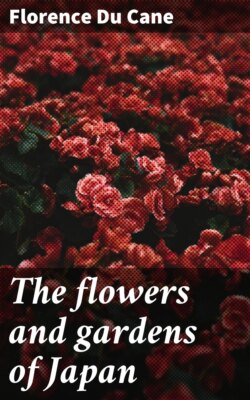The flowers and gardens of Japan

Реклама. ООО «ЛитРес», ИНН: 7719571260.
Оглавление
Florence Du Cane. The flowers and gardens of Japan
The flowers and gardens of Japan
Table of Contents
PREFACE
FLOWERS & GARDENS OF JAPAN
CHAPTER I. LANDSCAPE GARDENING
CHAPTER II. STONES—GARDEN ORNAMENTS AND FENCES
CHAPTER III. LANDSCAPE GARDENS
CHAPTER IV. NURSERY GARDENS—DWARF TREES AND HACHI-NIWA
CHAPTER V. TEMPLE GARDENS
CHAPTER VI. SUMMER FLOWERS
CHAPTER VII. PLUM BLOSSOM
CHAPTER VIII. PEACH BLOSSOM
CHAPTER IX. CHERRY BLOSSOM
CHAPTER X. WISTARIA AND PÆONY
CHAPTER XI. AZALEAS
CHAPTER XII. THE IRIS
CHAPTER XIII. THE MORNING GLORY
CHAPTER XIV. THE LOTUS
CHAPTER XV. THE CHRYSANTHEMUM
CHAPTER XVI. THE MAPLE LEAVES
CHAPTER XVII. THE BAMBOO
CHAPTER XVIII. THE PINE-TREE
Отрывок из книги
Florence Du Cane
Published by Good Press, 2019
.....
Probably the garden ornaments which will first attract the eye of the visitor are the stone lanterns, which are to be found in almost every garden, however humble. These lanterns appear to be of purely Japanese origin; no record of them is to be found in the history of Chinese gardens, though the introduction of miniature stone pagodas as garden ornaments came to Japan from China through the medium of Korea, for which reason they are still called “Korean Towers.” The use of stone lanterns as a decoration for gardens seems to date from the days when the Professors of Tea-ceremonial turned their attention to landscape gardening. The custom of presenting votive offerings of lanterns in bronze or stone, large or small, plain or decorated, dates from early days, and no Buddhist temple or shrine is complete without its moss-grown lanterns adorning the courts and grounds. The correct placing of stone lanterns in the landscape garden is almost as complex as the placing of stones. They should be used in combination with rocks, shrubs and trees, and water-basins. They have no use except as ornaments, as seldom, if ever, did I see one with a light in its fire-box except in temple grounds. They appeared to be almost more valued for their age than their form, as new ones can be easily procured of any desired shape; but however ingenious the devices may be for imparting a look of age to new specimens, it is time, and time alone, which will bring that thick green canopy of velvet moss on their roof, and the granite will only become toned down to the coveted mellow hue by long exposure to the weather.
Roughly speaking, garden lanterns are divided into two classes, the Standard and the Legged class, though many others of fanciful design may sometimes be seen. The origin of the Standard class was known as the “Kasuga” shape, after a Shinto god to whom the well-known Nara temple is dedicated. Thousands of these Kasuga lanterns adorn the temple grounds, and the exact form is that of “a high cylindrical standard, with a small amulet in the centre, erected on a base and plinth of hexagonal plan, and supporting an hexagonal head crowned with a stone roof of double curve, having corner scrolls. The top is surmounted with a ball drawn to a point above. The head of the lantern, which is technically called the fire-box, is hollowed out, two of its faces having a square opening large enough to admit an oil lamp; and the remaining four sides being carved respectively with representations of a stag, a doe, the sun, and the moon.” These lanterns may vary in size, from six to as much as eighteen feet, and in this colossal size make a most imposing decoration for a large garden. There are several other designs which closely resemble the true Kasuga shape. Many others there are which still belong to the Standard class: some with the standards shortened and the heads elongated; others with flat saucer-shaped caps or wide mushroom-shaped roofs—in fact, an infinite variety; and even in humble gardens rude specimens are seen built of natural mossy stones chosen to resemble as closely as possible the regulation form, and the fire-box made of wood. Another form of the Standard shape is suggestive of glorified lamp-posts; these lanterns are mostly used in the approach to gardens or near the tea-rooms. Some of them are very quaint and quite rustic in appearance, being always made of wood. The square wooden lantern on a tall post is covered by either a wooden or thatched roof with
.....